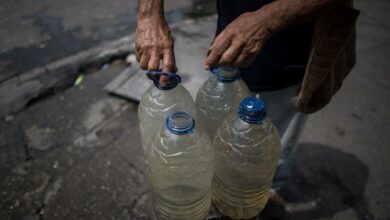Battered bolivar plays vital role in crisis-hit Venezuela

By Carlos Seijas Meneses
Caracas, Mar 8 (EFE).- The bolivar has gone through different adjustments this century as part of the Venezuelan government’s bid to tame hyperinflation.
But now it is playing a pivotal role in that South American country’s de facto dollarized economy, making up for a scarcity of low-denomination greenbacks needed for retail transactions.
That dynamic can be seen at stores and street stalls on Quinta Crespo, a busy commercial district of downtown Caracas, where bolivars are used to purchase food items like meat, maize flour, eggs, coffee, milk cream, tomatoes, plantains, peaches and strawberries, several store owners and street sellers told Efe.
The manager of one of those retail outlets, who preferred not to be identified, said consumers pay everything that costs less than $5 in local currency.
He added that they mainly use 500,000 and 1 million bolivar bills, which were supposedly going to be phased out after last October’s monetary overhaul hacked six zeros off the local currency and created a new, so-called “digital bolivar.”
(Banknotes were printed as part of that adjustment, although the government wants Venezuelans to use a digital version to facilitate daily transactions)
“People buy small things (with bolivars) … they pay for the suero (milk cream) that costs 3.5 (digital) bolivars … or some 100-gram bags of coffee that are 2.5 (digital) bolivars,” Yenifer Perez, a seller at another retail outlet in Quinta Crespo, told Efe.
Venezuela’s Central Bank (BCV) on March 8, 2021, shook up its then-existent currency regime, introducing three new large-denomination bolivar notes – 200,000, 500,000 and 1,000,000 bills – to counter hyperinflation.
A year later, those latter two notes – equal to around 0.5 and 1 digital bolivars, respectively – are currently the most-circulated local currency bills on the Venezuelan streets, even outpacing the five and 10 digital bolivar notes issued five months ago as part of that nation’s third monetary overhaul this century.
According to BCV data, 52 million 500,000 bolivar and 56.2 million 1,000,000 bolivar notes were put into circulation in October and November, after the latest monetary overhaul had already taken effect.
By contrast, there is no sign of any 20, 50 or 100 digital bolivar notes in circulation on the street, and the BCV’s records show no indication that any those banknotes – introduced as part of the latest overhaul – have been printed.
Older bills that date back prior to last year’s adjustments are now out of circulation and used only as arts-and-crafts material and stationery.
Juan Carlos, an appliance repairman, told Efe while waiting for a bus in central Caracas that the dollar is the dominant currency in the marketplace but that bolivars are needed, for example, to buy low-cost items like bus tickets and cooking gas cylinders.
A 10-kilogram gas cylinder sells for 4.5 digital bolivars and payment in foreign currency is not accepted, while the cost of a ticket from downtown Caracas’ Chacaito district to the suburb of La Trinidad is two digital bolivars, or just under $0.50.
Bolivars are in circulation at the small number of service stations that still sell subsidized gasoline for around 0.11 digital bolivars per liter, while the dollar is used at unsubsidized stations where that fuel is sold for around $0.50 a liter. EFE
csm/mc





